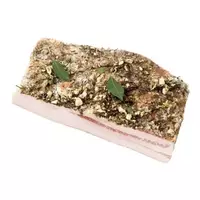Salo lardo

A country like Italy is famous not only for its distinctive history and culture, but also for its fashionable moles. The Italian culinary tradition has become a real hallmark of the country, in which tourists from all over the planet Earth come every year to taste amazing classics of Italian cuisine.
We think that many will easily be able to recall such nationally famous Italian dishes as pasta or pizza. However, do not forget that over the many centuries-old history of existence in national Italian cuisine, in addition to the above delicacies, thousands of recipes for all kinds of culinary products have accumulated.
The strength of Italian cuisine has always been considered meat dishes, as well as meat and sausage products. Many believe that such a product as lard refers exclusively to the national preference of the inhabitants of Ukraine. However, Italians also do not mind feasting on lard. Lardo or lardo is a premium product.
The history of Lard Lardo began in a village called Colonnata, which is located in the heart of the Apuan Alps of the modern Italian region of Tuscany. Researchers believe that Lardo's first lard began to be made in ancient Rome. In ancient times, Colonnata was a small Roman town. To make Lardo lard, certain breeds of pigs are used, which are subject to strict control.
As a rule, pigs at least nine months old, and whose weight does not exceed 160 kilograms, are selected to cook Lardo lard. In the original formulation of Largo lard, it is imperative to use special troughs of Carrara marble, which is mined in the region, to prepare the product. Initially, Lardo's lard referred to the so-called cucina povera, which literally means "cuisine of the poor. "
However, thanks to its outstanding taste properties, Lardo lard quickly gained popularity among all segments of the population. In the process of making Lardo lard, only fresh pork speck is used, which is a strip of fatty tissue from the back to the belly of the animal.
Lard is placed in a marble trough and thoroughly rinsed with garlic, and then sprinkled with sea salt. In addition, Lardo's lard uses a mixture of spices and spices, which includes black peppers, garlic, sage and rosemary. The spice mixture is called camicia or shirt. The lard is laid out in layers and then kept under a marble press for at least half a year.
Moreover, Lardo's lard is stored not only in special containers, but also in a specially equipped basement, where the temperature and humidity level of the room are monitored. Lardo's salo is considered ready if it has a dark color on the outside and a gently pink tint of flesh. Lardo's salo is served as a snack at the table, and is also used in the process of cooking meat and fish dishes, pasta or pizza.
lard lardo 840.8 kCal
Energy value of lard lardo (Ratio of proteins, fats, carbohydrates - ju):
Proteins: 1.4 g (~ 6 kCal)
Fats: 92.8 g. (~ 835 kCal)
Carbohydrates: 0 g (~ 0 kCal)
Energy ratio (bj | y): 1% | 99% | 0%
 Español
Español Français
Français Português
Português Русский
Русский 简体中文
简体中文 繁體中文
繁體中文 日本語
日本語 한국어
한국어 العربية
العربية Türkçe
Türkçe Қазақ
Қазақ Deutsch
Deutsch Italiano
Italiano Українська
Українська
